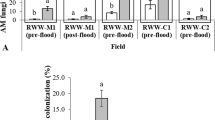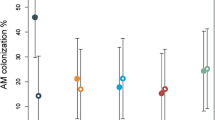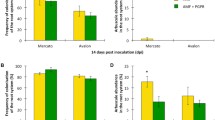Abstract
In southwestern Australia fields, colonization of wheat roots by arbuscular mycorrhizal fungi (AMF) is reduced due to repeated use of phosphate (P) fertilizers. We predicted AMF that aggressively colonize wheat roots at low P supply would also aggressively colonize at high P supply, but provide no additional P uptake benefit and reduce growth. Wheat (cv. Kulin) seedlings were non-mycorrhizal (NM) or inoculated separately with 10 isolates of AMF from wheat-belt soils in a glasshouse experiment. Kojonup loamy sand was supplied with P to provide suboptimal and supraoptimal P for growth of NM wheat in this soil. At low P supply, wheat growth was limited by P availability. All AMF isolates colonized wheat roots at 14 days after emergence of seedlings. At 42 days, percentage root length colonized (%RLC) was highest for two isolates of Scutellospora calospora, WUM 12(2) and WUM 12(3), followed by Glomus sp. WUM 51, G. invermaium WUM 10(1), Acaulospora laevis WUM 11(4) and Gigaspora decipiens WUM 6(1). These isolates, designated as `aggressive colonizers', ranged from 50 to 89%RLC. A second group of AMF ranged from 1 to 19%RLC at 42 days. This group, termed `non-aggressive colonizers', included Acaulospora spp. WUM 11(1), WUM 46, and WUM 49 and Glomus sp. WUM 44. High soil P supply increased seedling growth 2–3 fold, but reduced%RLC. Grouping of aggressive and non-aggressive AMF based on colonization rate at high P supply was similar to that at low P. At low P supply, only the two isolates of S. calospora increased wheat growth compared to the NM plant. The remaining aggressive and non-aggressive AMF reduced growth of wheat at low P, while aggressive colonizers reduced growth at high P. At low P supply, the aggressive colonizers increased shoot P concentration, while at high P, shoot P was not affected by AMF. Growth depression by aggressive colonizers was associated with reduced sucrose concentration in roots. Based on the negative growth response under low and high P fertility in the glasshouse, AMF could be expected to produce non-beneficial effects on wheat in the field depending on the P status of the soil and the aggressiveness of AMF in the community.
Similar content being viewed by others
References
Abbott L K and Gazey C 1994 An ecological view of the formation of VA mycorrhizas. Plant Soil 159, 69–78.
Abbott L K and Robson A D 1981 Infectivity and effectiveness of vesicular-arbuscular mycorrhizal fungi: Effect of inoculum source. Aust. J. Agric. Res. 1, 631–639.
Abbott L K and Robson A D 1991 Factors influencing the occurrence of vesicular-arbuscular mycorrhizal fungi. Agric. Ecosys. Environ. 35, 120–150.
Brundrett M 1991 Mycorrhizas in natural ecosystems. Adv. Ecol. Res. 21, 171–313.
Chan K Y and Mead J A 1992 Tillage-induced differences in growth and distribution of wheat roots. Aust. J. Agric. Res. 43, 19–28.
Colwell J D 1963 The estimation of the phosphorus fertilizer requirements of wheat in southern NSW by soil analysis. Aust. J. Agric. Animal Husb. 3, 190–197.
Douds D D, Galvez L, Becard G and Kapulnik Y 1998 Regulation of arbuscular mycorrhizal development by plant host and fungus species in alfalfa. New Phytol. 138, 27–35.
Gavito M E and Miller M H 1998 Early phosphorus nutrition, mycorrhizae development, dry matter partitioning and yield of maize. Plant Soil 199, 177–186.
Gazey C, Abbott L K and Robson A D 1992 The rate of development of mycorrhizas affects the onset of sporulation and production of external hyphae by two species of Acaulospora. Mycol. Res. 96, 643–650.
Giovanetti M and Mosse B 1980 An evaluation of techniques for measuring vesicular-arbuscular mycorrhizal infection in roots. New Phytol. 84, 489–500.
Graham J H and Eissenstat D M 1994 Host genotype and the formation and function of VA mycorrhizae. Plant Soil 159, 179–185.
Graham J H and Eissenstat D M 1998 Field evidence for carbon cost of citrus mycorrhizas. New Phytol. 140, 103–110.
Graham J H, Drouillard D L and Hodge N C 1996 Carbon economy of sour orange in response to different Glomus spp. Tree Physiol. 16, 1023–1029.
Graham J H, Duncan L W and Eissenstat D M 1997 Carbohydrate allocation patterns in citrus genotypes as affected by phosphorus nutrition, mycorrhizal colonization and mycorrhizal dependency. New Phytol. 135, 335–343.
Hetrick B A D, Wilson G W T and Leslie J F 1991 Root architecture of warm-and cool-season grasses: relationship to mycorrhizal dependency. Can. J. Bot. 69, 112–118.
Hetrick B A D, Wilson G W T and Cox T S 1992 Mycorrhizal dependence of modern wheat cultivars and ancestors. Can. J. Bot. 70, 2032–2040.
Hetrick B A D, Wilson G W T and Cox T S 1993 Mycorrhizal dependence of modern wheat cultivars and ancestors: a synthesis. Can. J. Bot. 71, 512–518.
Jakobsen I, Abbott L K and Robson A D 1992 External hyphae of vesicular-arbuscular mycorrhizal fungi associated with Trifolium subterraneum L. 1. Spread of hyphae and phosphorus inflow into roots. New Phytol. 120, 371–380.
Johnson N C 1993 Can fertilization of soil select less mutualistic mycorrhizae? Ecol. Applic. 3, 749–757.
Johnson N C and Pfleger F L 1992 Vesicular-arbuscular mycorrhizae and cultural stresses. In Mycorrhizae in Sustainable Agriculture. Eds GJ Bethlenfalvay and RG Linderman. pp. 71–99. ASA, Madison, WI.
Johnson N C, Copeland P J, Crookston R K and Pfleger F L 1992 Mycorrhizae: possible explanation for yield decline with continuous corn and soybean. Agron. J. 84, 387–390.
Johnson N C, Graham J H and Smith F A 1997 Functioning of mycorrhizal associations along the mutualism-parasitism continuum. New Phytol. 135, 575–585.
McGonigle T P and Miller M H 1996 Mycorrhizae, phosphorus absorption and yield of maize in response to tillage. Soil Sci. Soc. Am. J. 60, 1856–1861.
Miller R M and Jastrow J D 1992 The role of mycorrhizal fungi in soil conservation. In Mycorrhizae in Sustainable Agriculture. Eds GJ Bethlenfalvay and RG Linderman. pp. 29–44. ASA Special Publication Number 54.
Peng S, Eissenstat D M, Graham J H and Williams K 1993 Growth depression in mycorrhizal citrus at high phosphorus supply: analysis of carbon costs. Plant Physiol. 101, 1063–1071.
Ryan M H, Chilvers G A and Dumarsq D C 1994 Colonization of wheat by VA-mycorrhizal fungi was found to higher on a farm managed in an organic manner than on a conventional neighbour. Plant Soil 160, 33–40.
Schenck N C and Siquiera J O 1987 Ecology of VA mycorrhizal fungi in temperate agroecosystems. In Mycorrhizae in the Next Decade - Practical Solutions and Research Priorities. Eds DM Sylvia, LL Hung and JH Graham. pp. 2–4. Univ. of Florida, Gainesville.
Siqueira J O, Colozzi-Filho A and Oliveira E 1989 Ocurrencia de micorrizas vesiculo-arbusculares em agro e ecossistemas naturais do etado de Minas Gerais. Pesqui. Agropecu. Bras. 24, 1499–1506.
Smith S E, Robson A D and Abbott L K 1992 The involvement of mycorrhizas in assessment of genetically dependent efficiency of nutrient uptake and use. Plant Soil 146, 169–179.
Thompson J P 1987 Decline of vesicular-arbuscular mycorrhizae in long fallow disorder of field crops and its expression in phosphorus deficiency of sunflower. Aust. J. Agric. Res. 38, 847–67.
Toth J D, Toth D, Starke D and Smith D R 1990 Vesicular-arbuscular mycorhizal colonization of Zea mays affected by breeding for resistance to fungal pathogens. Can. J. Bot. 68, 1039–1044.
Vivekanandan M and Fixen P E 1991 Cropping systems effects on mycorrhizal colonization, early growth and P uptake of corn. Soil Sci. Soc. Am. J. 55, 136–140.
Wilson J M and Trinick M J 1983 Infection development and interactions between vesicular-arbuscular mycorrhizal fungi. New Phytol. 93, 543–553.
Rights and permissions
About this article
Cite this article
Graham, J.H., Abbott, L.K. Wheat responses to aggressive and non-aggressive arbuscular mycorrhizal fungi. Plant and Soil 220, 207–218 (2000). https://doi.org/10.1023/A:1004709209009
Issue Date:
DOI: https://doi.org/10.1023/A:1004709209009




